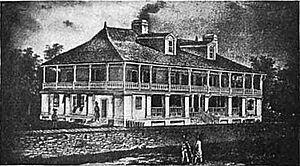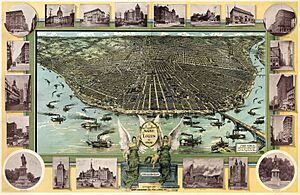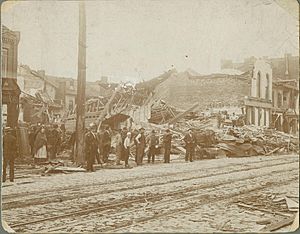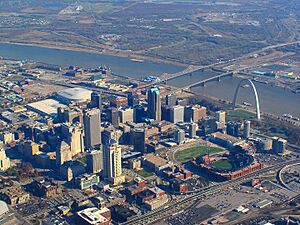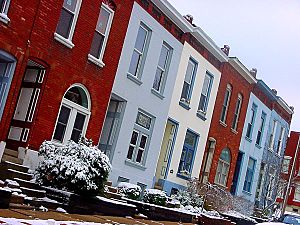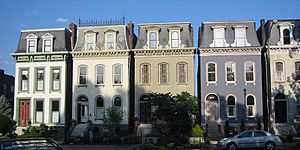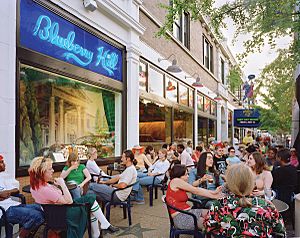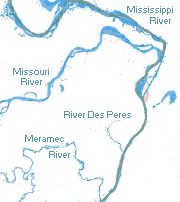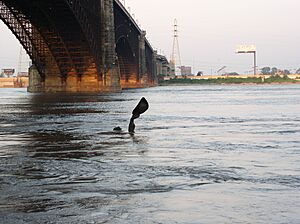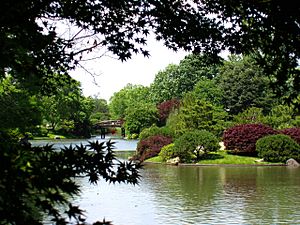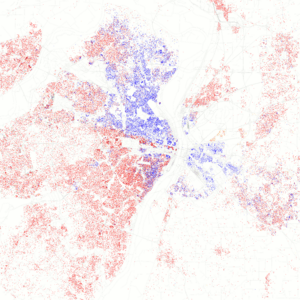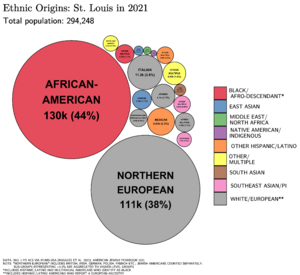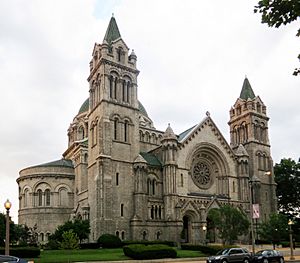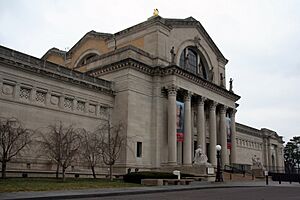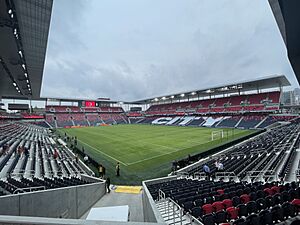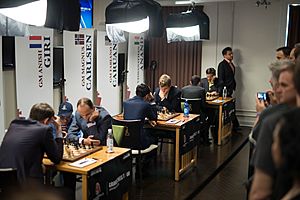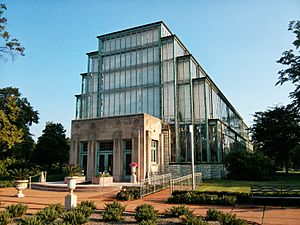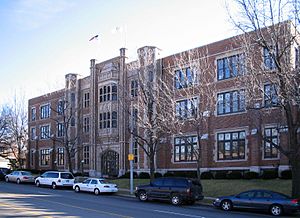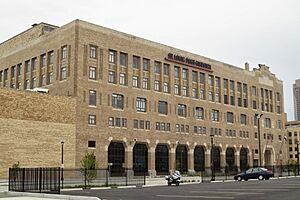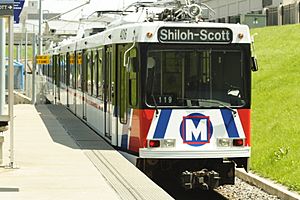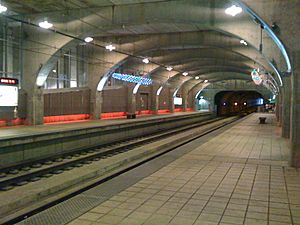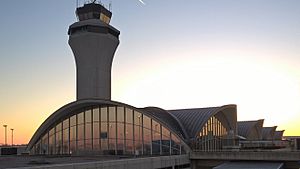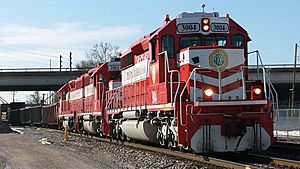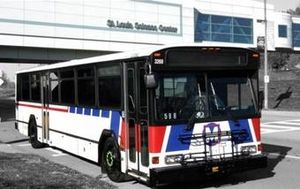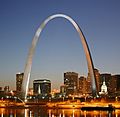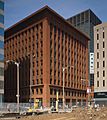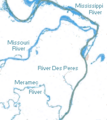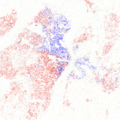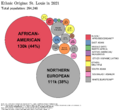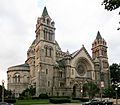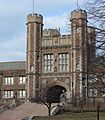St. Louis facts for kids
Quick facts for kids
St. Louis
|
|||||
|---|---|---|---|---|---|
|
|||||
| Nickname(s):
"Gateway to the West", The Gateway City, Mound City, The Lou, Rome of the West, River City, The STL, St. Lou
|
|||||
| Country | United States | ||||
| State | Missouri | ||||
| CSA | St. Louis–St. Charles–Farmington, MO–IL | ||||
| Metro | St. Louis, MO-IL | ||||
| Founded | February 14, 1764 | ||||
| Incorporated | 1822 | ||||
| Named for | Louis IX of France | ||||
| Government | |||||
| • Type | Mayor–council | ||||
| • Body | Board of Aldermen | ||||
| Area | |||||
| • Independent city | 66.17 sq mi (171.39 km2) | ||||
| • Land | 61.72 sq mi (159.85 km2) | ||||
| • Water | 4.45 sq mi (11.53 km2) | ||||
| • Urban | 910.4 sq mi (2,357.8 km2) | ||||
| • Metro | 8,458 sq mi (21,910 km2) | ||||
| Elevation | 466 ft (142 m) | ||||
| Highest elevation | 614 ft (187 m) | ||||
| Population
(2020)
|
|||||
| • Independent city | 301,578 | ||||
| • Estimate
(2021)
|
293,310 | ||||
| • Rank | US: 76th Midwest: 13th Missouri: 2nd |
||||
| • Density | 4,886.23/sq mi (1,886.59/km2) | ||||
| • Urban | 2,156,323 (US: 22nd) | ||||
| • Urban density | 2,368.6/sq mi (914.5/km2) | ||||
| • Metro | 2,809,299 (US: 21st) | ||||
| • CSA | 2,914,230 (US: 20th) | ||||
| Demonym(s) | St. Louisan; Saint Louisan | ||||
| GDP | |||||
| • Greater St. Louis | 9.9 billion (2022) | ||||
| Time zone | UTC−6 (CST) | ||||
| • Summer (DST) | UTC−5 (CDT) | ||||
| ZIP Codes |
List
|
||||
| Area code | 314/557 | ||||
| FIPS code | 29-65000 | ||||
St. Louis is an independent city in the state of Missouri. It is located where the Mississippi and Missouri rivers meet. In 2020, St. Louis had a population of over 300,000 people. Its larger metropolitan area, which includes parts of Illinois, has more than 2.8 million residents. This makes it the largest metropolitan area in Missouri.
Native American cultures lived in the St. Louis area for thousands of years before Europeans arrived. French fur traders founded the city on February 14, 1764. They named it after King Louis IX of France. St. Louis quickly became an important center for the French in the Illinois Country. In 1804, the United States bought St. Louis as part of the Louisiana Purchase. During the 1800s, it grew into a major port on the Mississippi River. From 1870 to the 1920s, it was the fourth-largest city in the U.S. In 1904, St. Louis hosted the Louisiana Purchase Exposition, also known as the World's Fair, and the Summer Olympics.
Today, St. Louis is known as a "global city" with a strong economy. It has important industries like services, manufacturing, trade, transportation, and aviation. Many large companies have their headquarters or major operations here. St. Louis is also home to major research universities such as Washington University in St. Louis and Saint Louis University.
The city has four professional sports teams: the St. Louis Cardinals (baseball), the St. Louis Blues (hockey), St. Louis City SC (soccer), and the St. Louis BattleHawks (football). Famous attractions include the 630-foot (192 m) Gateway Arch, the St. Louis Zoo, and the Missouri Botanical Garden.
Contents
- Exploring the History of St. Louis
- Geography and Landmarks of St. Louis
- St. Louis Population and Economy
- St. Louis Economy and Major Companies
- Arts and Culture in St. Louis
- Sports in St. Louis
- Parks and Recreation in St. Louis
- Education in St. Louis
- Media in St. Louis
- Transportation in St. Louis
- Notable People from St. Louis
- Sister Cities of St. Louis
- Images for kids
- See also
Exploring the History of St. Louis
Early Native American Cultures and European Arrival
![]() Kingdom of France 1690s-1763
Kingdom of France 1690s-1763
![]() Kingdom of Spain 1763–1800
Kingdom of Spain 1763–1800
![]() French First Republic 1800–1803
French First Republic 1800–1803
![]() United States 1803–present
United States 1803–present
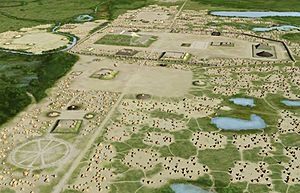
The land where St. Louis now stands was once a major center for the Native American Mississippian culture. These people built many large earthwork mounds on both sides of the Mississippi River. Their main city was Cahokia Mounds, which was active from 900 AD to 1500 AD. Because of the many mounds in the area, St. Louis was once called the "Mound City." Most of these mounds were removed as the city grew.
European explorers first recorded visiting the area in 1673. French explorers Louis Jolliet and Jacques Marquette traveled through the Mississippi River valley. Five years later, La Salle claimed the entire region for France, calling it La Louisiane.
The first European settlements in the area were French villages built on the east side of the Mississippi River in the late 1600s and early 1700s. These included Cahokia and Kaskaskia. Later, in the 1730s, French settlers from the east side founded Ste. Genevieve.
In early 1764, after France lost the Seven Years' War, Pierre Laclède and his stepson Auguste Chouteau founded what would become St. Louis. France had given its lands east of the Mississippi to Great Britain and lands west of the Mississippi to Spain. The early French families built the city's economy on the fur trade with Native American tribes.
From 1762 to 1803, Spain controlled the land west of the Mississippi, known as Louisiana. In 1780, during the American Revolutionary War, British forces and their Native American allies attacked St. Louis in the Battle of St. Louis.
Founding the City: French and Spanish Times
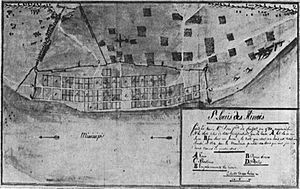
The founding of St. Louis began in 1763. Pierre Laclède led a group to set up a fur-trading post further up the Mississippi River. He and his partner, Gilbert Antoine de St. Maxent, were given special rights to trade furs in that area for six years.
Even though they were only supposed to set up a trading post, Laclede and his team quickly started a settlement. Laclede was joined by his young stepson, Auguste Chouteau. For the first few years, no government officially recognized St. Louis. This meant St. Louis had no local government. Laclede took charge, and problems were solved in public meetings. Many early settlers called these first years "the golden age of St. Louis."
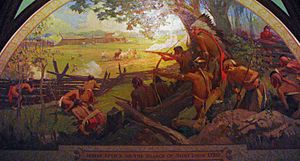
By 1765, St. Louis started getting visits from English, French, and Spanish officials. Local Native American tribes were not happy about being under British control. A great Ottawa chief, Pontiac, wanted to fight the British, but many St. Louis residents refused.
St. Louis was given back to France in 1800, though Spanish officials still managed the land. Then, in 1803, France sold it to the U.S. as part of the Louisiana Purchase. St. Louis became the capital and a key starting point for exploring the new territory. Soon after, the Lewis and Clark Expedition began from St. Louis in May 1804. They explored the vast territory, hoping to find a water route to the Pacific Ocean. They returned to St. Louis on September 23, 1806. Many other explorers and settlers later followed their path west.
St. Louis in the 1800s
The city elected its first local leaders in 1808. Steamboats first arrived in St. Louis in 1818, making trade with New Orleans and eastern markets much easier. Missouri became a state in 1821. St. Louis was officially made a city in 1822. It continued to grow because of its busy port and trade routes.
Many immigrants from Ireland and Germany arrived in St. Louis starting in the 1840s. The population of St. Louis grew from less than 20,000 in 1840 to over 160,000 by 1860. By the mid-1800s, St. Louis had more people than New Orleans.
During the American Civil War, the city was divided in its loyalties. In 1861, 28 civilians died in a clash with Union troops. The war hurt St. Louis's economy because the Union blocked river traffic to the south.
After the war, St. Louis thrived through trade with the West. The Eads Bridge, completed in 1874, helped connect industries on both sides of the river. This was the first bridge over the Mississippi River in the Midwest. It became a famous symbol of St. Louis until the Gateway Arch was built in 1965. Today, the Eads Bridge is used by cars, pedestrians, and the MetroLink light rail system.
On August 22, 1876, St. Louis voted to separate from St. Louis County. It became an independent city, which limited its political boundaries. Industrial production kept growing in the late 1800s. Major companies like Anheuser-Busch and Ralston Purina were founded. The Wainwright Building, an early skyscraper designed by Louis Sullivan, was built in 1892.
St. Louis in the 1900s
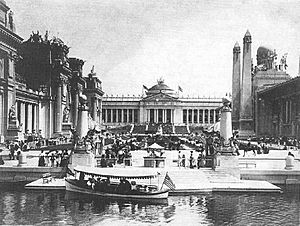
In 1904, St. Louis hosted the World's Fair and the 1904 Summer Olympics. It was the first city outside Europe to host the Olympics. Some buildings and areas from the fair still exist today, like Forest Park, the St. Louis Art Museum, the St. Louis Zoo, and the Missouri History Museum.
After the Civil War, there was a lot of unfair treatment in housing and jobs in St. Louis. In the early 1900s, many African Americans moved to St. Louis from the rural South as part of the Great Migration, looking for better opportunities. During World War II, the NAACP worked to make war factories open to everyone. In 1948, the U.S. Supreme Court ruled against housing rules that kept people apart based on race or religion.
In the first half of the 1900s, St. Louis had some of the worst air pollution in the U.S. In 1940, the city banned burning certain types of coal. By 1946, air pollution was reduced by about three-quarters.
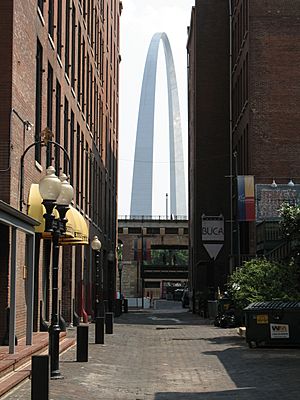
School segregation continued into the 1950s and 1970s. This led to a court case and an agreement to bus students from the city to county schools for integrated classes. The city also created special "magnet schools" to attract students.
St. Louis grew a lot in the early 1900s because of new industries, which created jobs for immigrants and people moving from the South. Its population reached its highest point of 856,796 in 1950. However, from the 1950s to the 1990s, many people moved to the suburbs. This caused the city's population to drop a lot. St. Louis is geographically small because it became an independent city, so it couldn't expand by adding nearby areas. This meant it lost a lot of its tax money.
In the 21st century, St. Louis has only about 11% of its total metropolitan population. Other large U.S. cities usually have about 24% of their metro population in the central city. Even though the city's population has slightly increased in the early 2000s, it still lost people from 2000 to 2010. New immigrants have continued to arrive, including people from Vietnam, Mexico, Central America, and Bosnia. St. Louis has the largest Bosnian community outside of Bosnia.
Several projects were built in the 1950s to replace old housing. Some of these projects had problems, and Pruitt–Igoe became a famous example of what went wrong. It was later torn down. Since the 1980s, there have been many efforts to improve and rebuild downtown St. Louis.
St. Louis in the 2000s
Urban renewal continued into the new century. Areas like the Washington Avenue Historic District have seen a lot of new development. In 2006, St. Louis won the World Leadership Award for its urban renewal efforts. In 2013, the U.S. Census Bureau estimated St. Louis's population at 318,416.
Geography and Landmarks of St. Louis
Cityscape Views
Famous Landmarks to See
| Name | Description | Photo |
|---|---|---|
| Gateway Arch | At 630-foot (192 m), it is the world's tallest arch and the tallest man-made monument in the Western Hemisphere. It was built to honor the westward expansion of the United States. It is the main feature of the Gateway Arch National Park. | 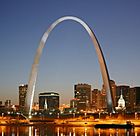 |
| St. Louis Art Museum | Built for the 1904 World's Fair, this museum has paintings, sculptures, and cultural items. It is in Forest Park, and admission is free. | 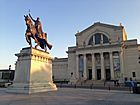 |
| Missouri Botanical Garden | Founded in 1859, this is one of the oldest botanical gardens in the U.S. It is a National Historic Landmark. It covers 79 acres and includes a 14-acre Japanese garden and the Climatron geodesic dome greenhouse. | 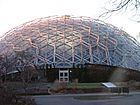 |
| Cathedral Basilica of St. Louis | Finished in 1914, this is the main church for the Roman Catholic Archdiocese of St. Louis. It is famous for its huge mosaics (one of the largest in the Western Hemisphere), burial crypts, and outdoor sculptures. |  |
| City Hall | Located in Downtown West, City Hall was designed in 1892. Its style is similar to the Hôtel de Ville, Paris in France. |  |
| Central Library | Completed in 1912, this building was designed by Cass Gilbert. It is the main location for the St. Louis Public Library. |  |
| City Museum | City Museum is a unique play museum made mostly from reused architectural and industrial objects. It is located in the former International Shoe building. | 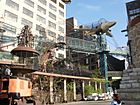 |
| Old Courthouse | Built in the 1800s, this building served as a federal and state courthouse. The famous Dred Scott case was heard here in 1846. | 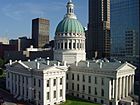 |
| St. Louis Science Center | Founded in 1963, it includes a science museum and a planetarium. It is in Forest Park. Admission is free, making it one of only two free science centers in the U.S. |  |
| St. Louis Symphony | Founded in 1880, the St. Louis Symphony Orchestra is the second-oldest symphony orchestra in the U.S. Its main concert hall is Powell Hall. | 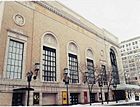 |
| Union Station | Built in 1894, this was once the city's main train station. It was the world's largest and busiest train station. In the 1980s, it was turned into a hotel, shopping center, and entertainment complex. Today, it also serves local light rail passengers. | 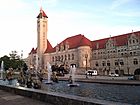 |
| St. Louis Zoo | Built for the 1904 World's Fair, this zoo is known for its animal care, research, and education. It is in Forest Park, and admission is free. |  |
St. Louis Architecture Styles
The buildings in St. Louis show many different styles. St. Louis is famous for the Gateway Arch, the tallest monument in the United States at 630 feet (190 m). The Arch honors Thomas Jefferson and St. Louis's role as the "gateway to the West." You can see influences from French, German, early American, and modern styles in the city's buildings.
Some tall, modern skyscrapers were built downtown in the 1970s and 1980s. These include the One US Bank Plaza (1976) and One Metropolitan Square (1989), which is the tallest building in St. Louis.
Many old churches from before the Civil War still stand. The Basilica of St. Louis, King of France (also called the Old Cathedral) was built between 1831 and 1834. Other old religious buildings include SS. Cyril and Methodius Church (1857) and Christ Church Cathedral (1867).
The Old St. Louis County Courthouse was finished in 1864. It was known for its early cast iron dome and was the tallest building in Missouri until 1894.
Because much of the city's early development was along the river, many old buildings were torn down when the Gateway Arch was built. However, a historic area called Laclede's Landing still exists. It has cobblestone streets and old brick warehouses, now popular for restaurants.
St. Louis saw a huge increase in different types of religious buildings in the late 1800s and early 1900s. The largest and most decorative is the Cathedral Basilica of St. Louis, built between 1907 and 1914. It has one of the world's largest collections of mosaics.
The 1904 World's Fair left many lasting structures. These include the St. Louis Art Museum and parts of the St. Louis Zoo in Forest Park. The Missouri History Museum was built later with money from the fair.
St. Louis Neighborhoods
The city is divided into 79 neighborhoods. These divisions do not have legal power, but some neighborhood groups manage grants or can stop new developments in historic areas.
Several neighborhoods are grouped into larger areas like "North City," "South City," and "The Central West End."
Here is a list of neighborhoods in St. Louis:
| 1 | Carondelet | 21 | Soulard | 41 | Cheltenham | 61 | Carr Square |
| 2 | Patch | 22 | Benton Park | 42 | Clayton/Tamm | 62 | Columbus Square |
| 3 | Holly Hills | 23 | McKinley Heights | 43 | Franz Park | 63 | Old North St. Louis |
| 4 | Boulevard Heights | 24 | Fox Park | 44 | Hi-Pointe | 64 | Near North Riverfront |
| 5 | Bevo Mill | 25 | Tower Grove East | 45 | Wydown/Skinker | 65 | Hyde Park |
| 6 | Princeton Heights | 26 | Compton Heights | 46 | Skinker/DeBaliviere | 66 | College Hill |
| 7 | Southampton | 27 | Shaw | 47 | DeBaliviere Place | 67 | Fairground |
| 8 | St. Louis Hills | 28 | Botanical Heights | 48 | West End | 68 | O'Fallon |
| 9 | Lindenwood Park | 29 | Tiffany | 49 | Visitation Park | 69 | Penrose |
| 10 | Ellendale | 30 | Benton Park West | 50 | Wells/Goodfellow | 70 | Mark Twain/I-70 Industrial |
| 11 | Clifton Heights | 31 | Gate District | 51 | Academy | 71 | Mark Twain |
| 12 | The Hill | 32 | Lafayette Square | 52 | Kingsway West | 72 | Walnut Park East |
| 13 | Southwest Garden | 33 | Peabody/Darst/Webbe | 53 | Fountain Park | 73 | North Point |
| 14 | North Hampton | 34 | LaSalle Park | 54 | Lewis Place | 74 | Baden |
| 15 | Tower Grove South | 35 | Downtown | 55 | Kingsway East | 75 | Riverview |
| 16 | Dutchtown | 36 | Downtown West | 56 | Greater Ville | 76 | Walnut Park West |
| 17 | Mount Pleasant | 37 | Midtown | 57 | The Ville | 77 | Grand Center |
| 18 | Marine Villa | 38 | Central West End | 58 | Vandeventer | 78 | Hamilton Heights |
| 19 | Gravois Park | 39 | Forest Park Southeast | 59 | JeffVanderLou | 79 | North Riverfront |
| 20 | Kosciusko | 40 | Kings Oak | 60 | St. Louis Place |
St. Louis Landscape and Rivers
St. Louis covers about 66 square miles (170 km2), with 62 square miles (160 km2) of land and 4.1 square miles (11 km2) of water. The city is built on hills and flat areas that rise above the western banks of the Mississippi River. This is just south of where the Missouri and Mississippi rivers meet. The area is mostly a fertile, gently rolling prairie with low hills and wide, shallow valleys. Both the Mississippi and Missouri rivers have created large valleys with wide flood plains.
The city's eastern border is the Mississippi River, which separates Missouri from Illinois. The Missouri River forms the northern border of St. Louis County. The Meramec River forms most of its southern border.
St. Louis Climate and Weather
St. Louis has a mix of humid continental and humid subtropical climates. This means it has hot, humid summers and chilly to cold winters. The city gets both cold Arctic air and hot, humid tropical air from the Gulf of Mexico. The average yearly temperature is about 57.1 °F (13.9 °C). Temperatures of 100 and 0 °F (38 and −18 °C) can happen a few days each year. The average yearly rainfall is about 41.0 inches (1,040 mm).
St. Louis has thunderstorms about 48 days a year. Especially in the spring, these storms can be strong, with high winds, large hail, and tornadoes. St. Louis is in Tornado Alley and has a history of damaging tornadoes. Severe flooding, like the Great Flood of 1993, can happen in spring and summer. This is often due to thick snow melting upstream in the Missouri or Mississippi Rivers.
| Climate data for St. Louis, Missouri (Lambert–St. Louis Int'l), 1981−2010 normals, extremes 1874−present | |||||||||||||
|---|---|---|---|---|---|---|---|---|---|---|---|---|---|
| Month | Jan | Feb | Mar | Apr | May | Jun | Jul | Aug | Sep | Oct | Nov | Dec | Year |
| Record high °F (°C) | 77 (25) |
85 (29) |
92 (33) |
93 (34) |
98 (37) |
108 (42) |
115 (46) |
110 (43) |
104 (40) |
94 (34) |
86 (30) |
76 (24) |
115 (46) |
| Mean maximum °F (°C) | 64.1 (17.8) |
69.8 (21.0) |
80.2 (26.8) |
86.7 (30.4) |
89.4 (31.9) |
94.8 (34.9) |
98.5 (36.9) |
99.3 (37.4) |
92.7 (33.7) |
85.7 (29.8) |
75.6 (24.2) |
65.0 (18.3) |
100.4 (38.0) |
| Mean daily maximum °F (°C) | 39.9 (4.4) |
45.0 (7.2) |
55.9 (13.3) |
67.4 (19.7) |
76.3 (24.6) |
85.1 (29.5) |
89.1 (31.7) |
87.9 (31.1) |
80.2 (26.8) |
68.5 (20.3) |
55.5 (13.1) |
42.5 (5.8) |
66.2 (19.0) |
| Daily mean °F (°C) | 31.8 (−0.1) |
36.3 (2.4) |
46.3 (7.9) |
57.3 (14.1) |
66.8 (19.3) |
75.9 (24.4) |
80.0 (26.7) |
78.6 (25.9) |
70.4 (21.3) |
58.7 (14.8) |
46.8 (8.2) |
34.7 (1.5) |
57.0 (13.9) |
| Mean daily minimum °F (°C) | 23.7 (−4.6) |
27.6 (−2.4) |
36.6 (2.6) |
47.2 (8.4) |
57.2 (14.0) |
66.8 (19.3) |
71.0 (21.7) |
69.4 (20.8) |
60.6 (15.9) |
49.0 (9.4) |
38.1 (3.4) |
26.9 (−2.8) |
47.9 (8.8) |
| Mean minimum °F (°C) | 4.2 (−15.4) |
8.0 (−13.3) |
18.4 (−7.6) |
31.5 (−0.3) |
43.2 (6.2) |
54.3 (12.4) |
60.3 (15.7) |
59.0 (15.0) |
44.8 (7.1) |
33.5 (0.8) |
22.4 (−5.3) |
7.5 (−13.6) |
−1.8 (−18.8) |
| Record low °F (°C) | −22 (−30) |
−18 (−28) |
−5 (−21) |
20 (−7) |
31 (−1) |
43 (6) |
51 (11) |
47 (8) |
32 (0) |
21 (−6) |
1 (−17) |
−16 (−27) |
−22 (−30) |
| Average precipitation inches (mm) | 2.40 (61) |
2.24 (57) |
3.32 (84) |
3.69 (94) |
4.72 (120) |
4.28 (109) |
4.11 (104) |
2.99 (76) |
3.13 (80) |
3.33 (85) |
3.91 (99) |
2.84 (72) |
40.96 (1,040) |
| Average snowfall inches (cm) | 5.6 (14) |
4.3 (11) |
2.3 (5.8) |
0.4 (1.0) |
0 (0) |
0 (0) |
0 (0) |
0 (0) |
0 (0) |
0 (0) |
0.7 (1.8) |
4.4 (11) |
17.7 (45) |
| Average precipitation days (≥ 0.01 in) | 8.9 | 8.0 | 10.3 | 11.3 | 11.9 | 10.0 | 8.9 | 8.2 | 7.4 | 8.7 | 9.6 | 9.4 | 112.6 |
| Average snowy days (≥ 0.1 in) | 4.7 | 3.4 | 1.7 | 0.3 | 0 | 0 | 0 | 0 | 0 | 0 | 0.7 | 3.7 | 14.5 |
| Average relative humidity (%) | 73.0 | 72.0 | 68.3 | 63.5 | 66.5 | 67.1 | 68.0 | 70.0 | 71.6 | 68.7 | 72.2 | 75.8 | 69.7 |
| Mean monthly sunshine hours | 161.2 | 158.3 | 198.3 | 223.5 | 266.5 | 291.9 | 308.9 | 269.8 | 236.1 | 208.4 | 140.9 | 129.9 | 2,593.7 |
| Percent possible sunshine | 53 | 53 | 53 | 56 | 60 | 66 | 68 | 64 | 63 | 60 | 47 | 44 | 58 |
| Source: NOAA (relative humidity and sun 1961−1990) | |||||||||||||
Plants and Animals in St. Louis

Before the city was founded, the area was mostly open forest and prairie. Native Americans kept this environment good for hunting by burning underbrush. The main trees are oak, maple, and hickory, similar to the nearby Ozarks. Common smaller trees include eastern redbud and flowering dogwood. Areas near rivers have many American sycamore trees.
Most neighborhoods in the city have large native shade trees. The biggest native forest area is in Forest Park. In autumn, the trees change color beautifully. Many different kinds of birds live here, including Canada gooses and mallard ducks. Gulls are common along the Mississippi River.
In winter, many bald eagles can be seen along the Mississippi River near the Chain of Rocks Bridge. St. Louis is on the Mississippi Flyway, a route used by migrating birds. The Eurasian tree sparrow, a bird from other parts of the world, is mostly found in the counties around St. Louis.
Frogs are common in spring, especially after a lot of rain. You can find American toads and spring peepers in almost every pond. Sometimes, there are many cicadas or ladybugs. Mosquitoes and houseflies can be annoying in July and August.
St. Louis Population and Economy
Population Changes Over Time
| Historical population | |||
|---|---|---|---|
| Census | Pop. | %± | |
| 1810 | 1,600 | — | |
| 1830 | 4,977 | — | |
| 1840 | 16,469 | 230.9% | |
| 1850 | 77,860 | 372.8% | |
| 1860 | 160,773 | 106.5% | |
| 1870 | 310,864 | 93.4% | |
| 1880 | 350,518 | 12.8% | |
| 1890 | 451,770 | 28.9% | |
| 1900 | 575,238 | 27.3% | |
| 1910 | 687,029 | 19.4% | |
| 1920 | 772,897 | 12.5% | |
| 1930 | 821,960 | 6.3% | |
| 1940 | 816,048 | −0.7% | |
| 1950 | 856,796 | 5.0% | |
| 1960 | 750,026 | −12.5% | |
| 1970 | 622,236 | −17.0% | |
| 1980 | 453,805 | −27.1% | |
| 1990 | 396,685 | −12.6% | |
| 2000 | 348,189 | −12.2% | |
| 2010 | 319,294 | −8.3% | |
| 2020 | 301,578 | −5.5% | |
| 2023 (est.) | 281,754 | −11.8% | |
| U.S. Decennial Census 2020 Census |
|||
St. Louis grew slowly until the American Civil War. Then, new industries and immigration caused a population boom. In the mid-1800s, many Irish and Germans arrived. Later, immigrants came from southern and eastern Europe. In the early 1900s, African Americans and white people moved from the South. Many African Americans came from Mississippi and Arkansas as part of the Great Migration.
The city's population reached its highest point in 1950. That year, 82% of St. Louis's population was white and 17.9% was African American. After World War II, people started moving to the suburbs. This was because they wanted new homes, were unhappy with city services, and could easily drive to work. This also led to "white flight," where many white families moved out of the city.
St. Louis's population has dropped a lot since 1950. This has left many empty homes and lots in the city. However, the population of the larger Greater St. Louis area has grown every year.
As of the 2010 United States census, St. Louis had 319,294 people. About 24% of the population was 19 or younger. The median age was about 34 years.
The African-American population mainly lives in the north side of the city. Among Asian Americans, the largest groups are Vietnamese, Chinese, and Indians. The Vietnamese community is mostly in the Dutchtown neighborhood. People of Mexican descent are the largest Latino group, living mostly in Dutchtown, Benton Park West, and Gravois Park. People of Italian descent are concentrated in The Hill.
In 2010, St. Louis had some of the highest rates of online charitable donations and volunteer work among major U.S. cities.
Most St. Louis residents speak English at home. However, many also speak Spanish, Serbo-Croatian, Vietnamese, African languages, Chinese, and French.
| Historical racial composition | 2020 | 2010 | 2000 | 1990 | 1970 | 1940 |
|---|---|---|---|---|---|---|
| White | 43.9% | 43.9% | 43.9% | 50.9% | 58.7% | 86.6% |
| —Non-Hispanic | 42.9% | 42.2% | 43.0% | 50.2% | 57.9% | 86.4% |
| Black | 43.0% | 49.2% | 51.2% | 47.5% | 40.9% | 13.3% |
| Hispanic or Latino (of any race) | 5.1% | 3.5% | 2.0% | 1.3% | 1.0% | 0.2% |
| Asian | 4.1% | 2.9% | 2.0% | 0.9% | 0.2% | (X) |
| Race / Ethnicity (NH = Non-Hispanic) | Pop 1990 | Pop 2000 | Pop 2010 | Pop 2020 | % 1990 | % 2000 | % 2010 | % 2020 |
|---|---|---|---|---|---|---|---|---|
| White alone (NH) | 198,956 | 142,329 | 134,702 | 129,368 | 50.15% | 42.89% | 42.19% | 42.90% |
| Black or African American alone (NH) | 187,805 | 177,446 | 156,389 | 128,993 | 47.34% | 50.96% | 48.98% | 42.77% |
| Native American or Alaska Native alone (NH) | 874 | 862 | 684 | 614 | 0.22% | 0.25% | 0.21% | 0.20% |
| Asian alone (NH) | 3,616 | 6,820 | 9,233 | 12,205 | 0.91% | 1.96% | 2.89% | 4.05% |
| Pacific Islander alone (NH) | N/A | 83 | 62 | 88 | N/A | 0.02% | 0.02% | 0.03% |
| Some Other Race alone (NH) | 310 | 647 | 478 | 1,773 | 0.08% | 0.19% | 0.15% | 0.59% |
| Mixed Race or Multi-Racial (NH) | N/A | 5,980 | 6,616 | 13,132 | N/A | 1.72% | 2.07% | 4.35% |
| Hispanic or Latino (any race) | 5,124 | 7,022 | 11,130 | 15,405 | 1.29% | 2.02% | 3.49% | 5.11% |
| Total | 396,685 | 348,189 | 319,294 | 301,578 | 100.00% | 100.00% | 100.00% | 100.00% |
Bosnian Community in St. Louis
About fifteen families from Bosnia settled in St. Louis between 1960 and 1970. After the Bosnian War began in 1992, many more Bosnian refugees arrived. By 2000, tens of thousands of Bosnian refugees had settled in St. Louis. Catholic aid groups helped them. Many were skilled workers who took any job they could find to support their families. Most Bosnian refugees are Muslim. They have mainly settled in south St. Louis and South County.
Bosnian-Americans are well-integrated into the city. They have started many businesses and cultural groups. An estimated 70,000 Bosnians live in the St. Louis area. This is one of the largest Bosnian populations outside of their home country. The highest number of Bosnians live in the Bevo Mill neighborhood and in nearby areas like Affton and Oakville.
St. Louis Economy and Major Companies
Understanding the St. Louis Economy
The total value of goods and services produced in Greater St. Louis was $209.9 billion in 2022. This was up from $192.9 billion the year before. In 2021, the average economic output per person in Greater St. Louis was $68,574. As of November 2024, the education and health services industries employ the most people in the region. Trade, transportation, utilities, and business services also employ many people.
Key Companies and Institutions
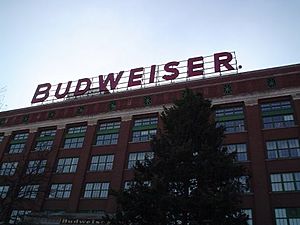
As of 2024, Greater St. Louis is home to six companies listed on the Fortune 500. These are Centene Corporation, Reinsurance Group of America, Emerson Electric, Edward Jones, Graybar Electric, and Ameren. Ten other companies in the area are on the Fortune 1000 list.
Other big companies headquartered here include Anheuser-Busch, Bunge Global, Wells Fargo Advisors, Enterprise Holdings, and World Wide Technology. Major companies with operations in St. Louis but headquarters elsewhere include Boeing, Bayer, and Mastercard.
The Federal Reserve Bank of St. Louis is one of two federal reserve banks in Missouri.
St. Louis is a hub for medicine and biotechnology. The Washington University School of Medicine is connected with Barnes-Jewish Hospital, one of the largest hospitals in the world. They both run the Alvin J. Siteman Cancer Center. The School of Medicine is also linked to St. Louis Children's Hospital, a top children's hospital. The McDonnell Genome Institute at Washington University helped a lot with the Human Genome Project.
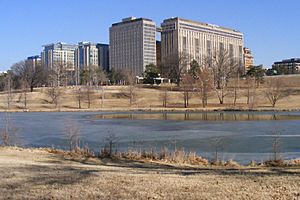
The Cortex Innovation Community in Midtown is the region's largest innovation center. It has offices for companies like Square, Microsoft, and Boeing. Cortex has created 3,800 tech jobs in 14 years. It is expected to bring in $2 billion in development and create 13,000 jobs. The nonprofit Arch Grants helps new startups come to the region. The nonprofit LaunchCode trains future tech workers.
According to the St. Louis Business Journal, the top employers in Greater St. Louis as of March 29th, 2023 are:
| # | Employer | # of local employees |
|---|---|---|
| 1 | BJC Health Care | 33,797 |
| 2 | Washington University | 21,278 |
| 3 | Walmart | 17,000 |
| 4 | Boeing Defense, Space & Security | 16,681 |
| 5 | SSM Health | 15,631 |
According to St. Louis's 2022 financial report, the top employers in the city itself as of 2021 are:
| # | Employer | # of Employees |
|---|---|---|
| 1 | Washington University | 19,380 |
| 2 | Barnes Jewish Hospital | 18,920 |
| 3 | Saint Louis University | 9,152 |
| 4 | City of St. Louis | 7,033 |
| 5 | Defense Finance and Accounting Service | 6,051 |
| 6 | Wells Fargo Advisors | 5,801 |
| 7 | U.S. Postal Service | 4,960 |
| 8 | St. Louis Board of Education | 4,131 |
| 9 | SSM SLUH | 3,794 |
| 10 | State of Missouri | 3,259 |
Arts and Culture in St. Louis
St. Louis has a rich history with its French past and many Catholic immigrants from Ireland, Germany, and Italy. This makes it a big center for Roman Catholicism in the United States. St. Louis is also known for its music and performing arts, especially blues, jazz, and ragtime. The St. Louis Symphony is the second oldest symphony orchestra in the United States.
The Gateway Arch is a key landmark downtown. This area also includes the Federal courthouse, a large public library, major churches, and businesses. More people are choosing to live downtown in renovated old buildings. In nearby University City, the Delmar Loop is a popular street with many shops, restaurants, and the Tivoli Theater, all within walking distance.
St. Louis has unique local foods that show its different immigrant groups. These include toasted ravioli, gooey butter cake, provel cheese, the slinger, the Gerber sandwich, and the St. Paul sandwich. Some chefs in St. Louis are now focusing on using local produce, meats, and fish. Farmers' markets have become more popular.
St. Louis-style pizza has a thin crust, provel cheese, and is cut into small squares. Ted Drewes is famous for its "Concrete," a thick frozen custard mixed with many ingredients. It's so thick that a spoon won't fall out if you turn the cup upside down!
Sports in St. Louis
Professional Sports Teams
St. Louis is home to the St. Louis Cardinals of Major League Baseball and the St. Louis Blues of the National Hockey League. In 2019, St. Louis became the eighth North American city to win championships in all four major sports leagues (MLB, NBA, NFL, and NHL) when the Blues won the Stanley Cup. A third major team, the St. Louis City SC of Major League Soccer, started playing in 2023.
Here are the professional sports teams in the St. Louis area:
| Club | Sport | First season | League | Venue |
|---|---|---|---|---|
| St. Louis Cardinals | Baseball | 1882 | Major League Baseball | Busch Stadium |
| St. Louis Blues | Ice hockey | 1967 | National Hockey League | Enterprise Center |
| St. Louis City SC | Soccer | 2023 | Major League Soccer | Energizer Park |
| St. Louis BattleHawks | American football | 2020 | United Football League | The Dome at America's Center |
| St. Louis City 2 | Soccer | 2022 | MLS Next Pro | Energizer Park |
| Gateway Grizzlies | Baseball | 2001 | Frontier League | Grizzlies Ballpark |
| St. Louis Ambush | Indoor soccer | 2013 | Major Arena Soccer League | Family Arena |

The St. Louis Cardinals are one of the most successful teams in Major League Baseball. They have won 19 National League titles and 11 World Series titles, most recently in 2011. They play at Busch Stadium. The 1944 World Series was special because both teams, the St. Louis Cardinals and the St. Louis Browns, were from St. Louis and played in the same stadium. The Cardinals won that series.

The St. Louis Blues of the National Hockey League (NHL) play at the Enterprise Center. They joined the NHL in 1967. The Blues reached the Stanley Cup finals in their first three years but lost each time. They finally won their first Stanley Cup in 2019, beating the Boston Bruins. This win made St. Louis the eighth city to win a championship in all four major U.S. sports.
St. Louis has been home to four National Football League (NFL) teams. The St. Louis Rams played here from 1995 to 2015 and won Super Bowl XXXIV in 2000. They moved back to Los Angeles in 2016.
The St. Louis Hawks of the National Basketball Association (NBA) played here from 1955 to 1968. They won the NBA championship in 1958. In 1968, the Hawks moved to Atlanta.
Major League Soccer's St. Louis City SC began playing in 2023 at Energizer Park. Their minor league team, St. Louis City 2, also plays there.
The St. Louis BattleHawks of the XFL started playing in 2020 at The Dome at America's Center.
St. Louis also has several minor league sports teams. The Gateway Grizzlies baseball team plays nearby in Sauget, Illinois. The St. Louis Ambush indoor soccer team plays in St. Charles.
College and Amateur Sports
St. Louis has hosted the Final Four for both men's and women's college basketball tournaments. Saint Louis University has won 10 NCAA men's soccer championships. Many St. Louisans have played for the U.S. men's national soccer team. St. Louis is also where the sport of corkball began, which is like baseball but without base running.
Chess in St. Louis
St. Louis is home to the Saint Louis Chess Club, where the U.S. Chess Championship is held. Rex Sinquefield founded the Chess Club and moved the World Chess Hall of Fame to St. Louis in 2011. The Sinquefield Cup Tournament started in St. Louis in 2013. In 2014, it was the highest-rated chess tournament ever. Famous chess players like Fabiano Caruana and Hikaru Nakamura have lived in St. Louis.
Parks and Recreation in St. Louis
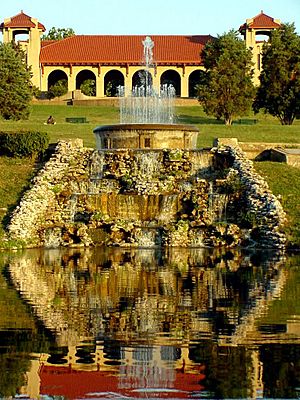
The city manages over 100 parks. These parks have sports facilities, playgrounds, concert areas, picnic spots, and lakes. Forest Park, on the western edge of the city, is the largest. It covers 1,400 acres, almost twice the size of Central Park in New York City. The park is home to five major attractions: the St. Louis Art Museum, the St. Louis Zoo, the St. Louis Science Center, the Missouri History Museum, and the Muny amphitheater.
Another important park is Gateway Arch National Park, located downtown along the riverfront. Its main feature is the 630-foot (192 m) tall Gateway Arch, completed in 1965. The historic Old Courthouse, where the first trials of the Dred Scott case were held, is also part of the park.
Other parks include the Missouri Botanical Garden, Tower Grove Park, and Citygarden. The Missouri Botanical Garden is a private garden and research center. It is a National Historic Landmark and one of the oldest botanical gardens in the U.S. It has 79 acres of plants from around the world, including a Japanese garden and the Climatron geodesic dome.
Education in St. Louis
Colleges and Universities
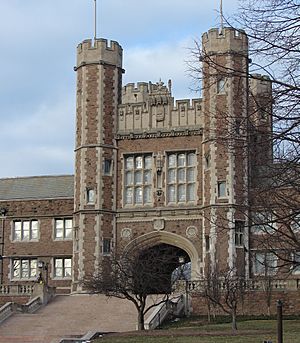
St. Louis is home to three national research universities: Washington University in St. Louis, Saint Louis University, and the University of Missouri–St. Louis. The Washington University School of Medicine in St. Louis is often ranked among the top medical schools in the country.
The St. Louis area also has other four-year colleges and universities. These include Harris–Stowe State University, a public university that was historically for Black students, and Webster University.
Primary and Secondary Schools
The St. Louis Public Schools (SLPS) system covers the entire city. It operates over 75 schools with more than 25,000 students, including several special "magnet schools." Since 2000, "charter schools" have also operated in St. Louis. These schools are sponsored by local groups and serve students from kindergarten through high school.
There are also many private schools in the city. The Archdiocese of St. Louis runs dozens of parochial schools (Catholic schools), including high schools. St. Louis also has private high schools that are not religious. St. Louis University High School, a Jesuit high school founded in 1818, is the oldest secondary school west of the Mississippi River. The state-run K-12 boarding school Missouri School for the Blind is also in St. Louis.
Media in St. Louis
The St. Louis area is the 24th-largest media market in the United States. All major U.S. television networks have local channels in St. Louis. Popular radio stations include KMOX (sports and talk, known for St. Louis Cardinals broadcasts) and KSHE 95 FM, which has played rock music since 1967, longer than any other U.S. radio station.
The St. Louis Post-Dispatch is the main newspaper in the region. Other local newspapers serve specific communities. There are also three weekly newspapers for the African-American community: the St. Louis Argus, the St. Louis American, and the St. Louis Sentinel. St. Louis Magazine is a monthly magazine that covers local history, food, and lifestyles. The weekly St. Louis Business Journal provides business news.
Many books and movies have been made about St. Louis. Some well-known films include Meet Me in St. Louis and American Flyers. Novels include The Killing Dance and Meet Me in St. Louis.
Transportation in St. Louis
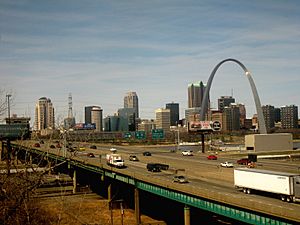
St. Louis has many ways to travel, including roads, trains, ships, and airplanes. These connect the city to nearby communities, national networks, and international places. St. Louis also has a public transportation system with buses and light rail service.
Roads and Highways
Four interstate highways connect the city to a larger regional highway system. Interstate 70 runs from the northwest to downtown. The north-south Interstate 55 enters from the south. Both Interstate 64 and Interstate 44 enter from the west. Two of these interstates (I-55 and I-64) merge south of the Gateway Arch National Park and cross into Illinois on the Poplar Street Bridge.
Major local roads include Memorial Drive, Grand Boulevard, and Jefferson Avenue. Gravois Road runs from the southeast to downtown.
MetroLink Light Rail System
The St. Louis area has MetroLink, a light rail system. It is the 11th-largest light rail system in the country, with 46 mi (74 km) of tracks. The Red Line and Blue Line both serve stations in the city and extend into the suburbs. All of the tracks are on their own path, with parts above ground and parts underground. All stations are easy to enter, and platforms are level with the trains. The Bi-State Development Agency runs the rail service, funded by sales taxes. The Gateway Multimodal Transportation Center downtown is a central station. It connects the light rail, local bus system, passenger trains, and national bus services.
Airports Serving St. Louis
St. Louis has two passenger airports. St. Louis Lambert International Airport, owned by the City of St. Louis, is 11 miles northwest of downtown. It is the largest and busiest airport in Missouri. In 2016, it had over 255 daily flights to about 90 places. The airport is a key hub for Southwest Airlines. It has two terminals with five concourses. International flights use Terminal 2. You can move between terminals using free buses or MetroLink.
MidAmerica St. Louis Airport is the second airport for the area. It is 17 miles east of downtown and serves domestic passengers.
Port Authority and River Transport
River transportation is available through the Port of St. Louis. This port covers 19.3 miles of the Mississippi River bank. It handles over 32 million tons of freight each year. The Port is the second largest inland port in the U.S. by trip-ton miles. It has over 100 docks for barges.
Railroad Services
Inter-city rail passenger train service is provided by Amtrak at the Gateway Multimodal Transportation Center downtown. Amtrak trains go to Chicago and Kansas City, Missouri. St. Louis is also a stop on the Texas Eagle route, which goes between Chicago, San Antonio, and Los Angeles.
St. Louis is the third largest freight rail hub in the nation. It moves Missouri exports like fertilizer, gravel, and cars. Freight rail service is provided by several companies, including Union Pacific Railroad and BNSF Railway.
Bus Services
Local bus service in St. Louis is provided by MetroBus. It has over 75 routes that connect to the MetroLink light rail and stops throughout the city and region. National bus service is offered by Greyhound Lines and Megabus.
Notable People from St. Louis
Sister Cities of St. Louis
St. Louis has 16 sister cities around the world:
- Bologna, Italy
- Bogor, Indonesia
- Brčko, Brčko District, Bosnia and Herzegovina
- Donegal, County Donegal, Ireland
- Galway, County Galway, Ireland
- Georgetown, Guyana
- Lyon, France
- Nanjing, China
- Rosario, Santa Fe, Argentina
- Saint-Louis, Senegal
- Samara, Russia
- San Luis Potosí, Mexico
- Stuttgart, Germany
- Suwa, Japan
- Szczecin, Poland
- Wuhan, China
Images for kids
See also
 In Spanish: San Luis (Misuri) para niños
In Spanish: San Luis (Misuri) para niños












